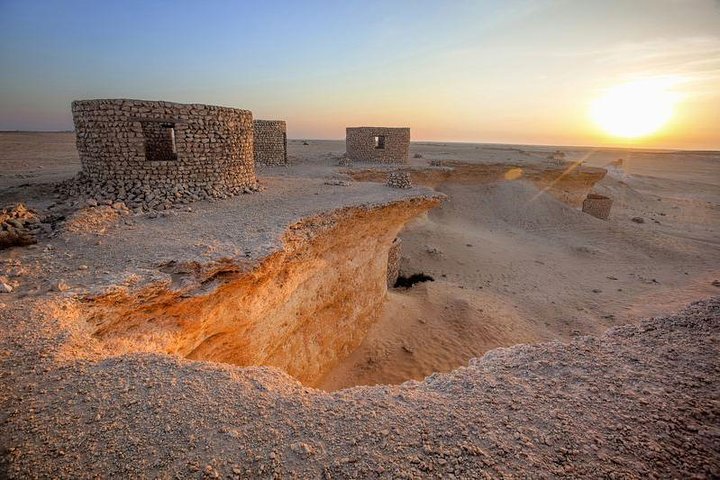Discovering Qatar’s Soul: A Spiritual Journey Through Souq Waqif and Beyond
Embark on a spiritual journey through Doha as I explore the vibrant Souq Waqif and the artistic grandeur of the Museum of Islamic Art. Join me as I delve into Qatar’s rich cultural heritage and discover the hidden treasures of its western frontier.
A Journey Through Time at Souq Waqif
As I stepped into the bustling lanes of Souq Waqif, I felt as though I had been transported back in time. The air was filled with the rich aroma of spices, and the vibrant colors of textiles and handicrafts surrounded me. This traditional market, nestled in the heart of Doha, is a living testament to Qatar’s rich cultural heritage. It is a place where the past and present coexist harmoniously, offering a unique glimpse into the soul of the nation.
Walking through the souq, I was reminded of the bustling bazaars of Cairo, where I spent my childhood. The lively atmosphere, the friendly banter of shopkeepers, and the diverse array of goods on display brought back fond memories. Here, in Souq Waqif, I found a similar sense of community and tradition, a place where people gather not just to trade, but to connect and share stories.
The souq is a treasure trove for those interested in history and culture. From traditional garments and jewelry to spices and perfumes, every corner of the market tells a story. I spent hours exploring the narrow alleys, each turn revealing a new discovery. The souq is also home to a variety of cafes and restaurants, offering a taste of authentic Qatari cuisine. As I sipped on a cup of fragrant Arabic coffee, I felt a deep sense of connection to the land and its people.
The Artistic Grandeur of the Museum of Islamic Art
Leaving the souq, I made my way to the Museum of Islamic Art (MIA), a short distance away along the Doha Corniche. The museum’s striking architectural design, set against the backdrop of the Arabian Gulf, is a sight to behold. Designed by the renowned architect I.M. Pei, the building itself is a masterpiece, reflecting the beauty and complexity of Islamic art.
Inside, the museum houses an extensive collection of Islamic art, spanning over 1,400 years. As a scholar of Islamic studies, I was particularly drawn to the exquisite calligraphy, ceramics, and textiles on display. Each piece is a testament to the rich artistic traditions of the Islamic world, offering a window into the spiritual and cultural heritage of the region.
The museum’s galleries are thoughtfully curated, guiding visitors on a journey through the history and evolution of Islamic art. As I wandered through the exhibits, I was struck by the diversity and depth of the collection. From the intricate patterns of Persian carpets to the delicate beauty of Ottoman ceramics, each artifact tells a story of creativity and devotion.
Exploring the Western Frontier of Qatar
The West of Qatar Tour offered a unique opportunity to explore the lesser-known treasures of Qatar’s western frontier. Our journey began with a visit to the Al Shahaniya Racetrack, where we witnessed the traditional sport of camel racing. This ancient practice holds deep cultural significance in the region, and watching the graceful camels race across the track was a thrilling experience.
Next, we ventured to the Zekreet Fort Ruins and the Mushroom Rock Formation, two of Qatar’s most striking natural landmarks. The rugged beauty of the landscape, with its unique rock formations and sweeping desert vistas, was awe-inspiring. Standing amidst the ruins, I felt a profound connection to the land and its history, a reminder of the enduring spirit of the people who once called this place home.
Our journey concluded with a visit to the Pearl Island and the Katara Cultural Village, two symbols of Qatar’s modernity and ambition. The Pearl Island, with its luxurious lifestyle and stunning architecture, is a testament to the country’s rapid development. Meanwhile, the Katara Cultural Village offers a rich blend of traditional Qatari architecture and modern design, serving as a hub for arts, culture, and heritage.
Reflecting on my journey, I realized that Qatar is a land of contrasts, where tradition and modernity coexist in harmony. From the bustling souqs and ancient ruins to the cutting-edge architecture and cultural landmarks, each experience offered a deeper understanding of the country’s rich heritage and vibrant future. This journey was not just an exploration of a place, but a spiritual pilgrimage, a chance to connect with the land and its people in a meaningful way.














































